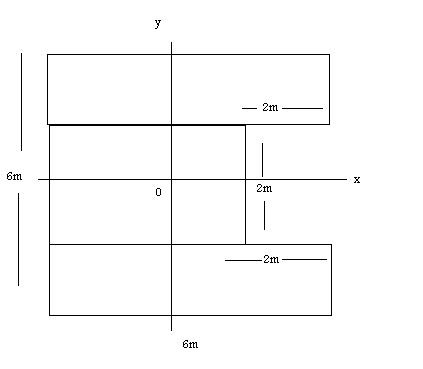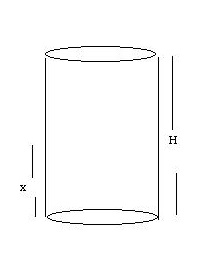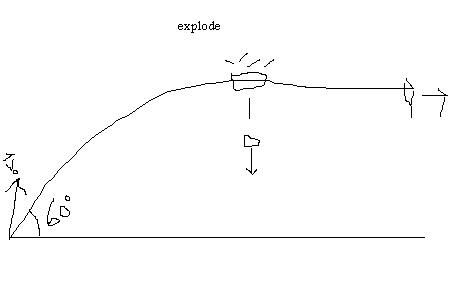Assignment:
Question 1. A uniform square plate 6m on a side has a had a square piece 2m on a side cut out of it. The center of that piece is at x=2m , y=0. The center of the square plate is at x=y=0. Fine (a) the x coordinate and (b) the y coordinate of the center of mass of the remaining piece

Question 2. A right cylindrical can with mass M , height H, and uniform density is initially filled with soda of mass m. We punch small holes in the top and bottom to drain the soda; we then consider the height h of the center of mass of the can and any soda within it. What is h (a) initially and (b) when all the soda has drained (c) What happens to h during the draining of the soda ? (d) If x is the height of the remaining soda at any given instant, find x in terms of M , H, and m when the center of mass reaches its lowest point

Question 3. A shell is shot with an initial velocity vector vo of 20 m/s, at an angle of 60 degrees with the horizontal. At the top of the trajectory, the shell explodes into two fragments of equal mass. One fragment, whose speed immediately after the explosion is zero, falls vertically. How far from the gun does the other fragment land, assuming that the terrain is level and that air drag is negligible ?

Question 4. Ricardo, of mass 80kg and Carmelita, who is lighter are enjoying Lake Mercen at dusk in a 30 kg canoe. When the canoe is at rest in the placid water, they exchange seats, which are 3.0 m apart and symmetrically located with respect to the canoe’s center. Ricardo notices that the canoe moves 40 cm relative to a submerged log during the exchange and calculates Carmelita’s mass, which she has not told him. What is it ?
Question 5. The last stage of a rocket, which is traveling at a speed of 7600 m/s, consists of two parts that are clamped together: a rocket case with a mass of 290.0 kg and a payload capsule with a mass of 150.0 kg. When the clamp is released, a compressed spring causes the two parts to separate with a relative speed of 910.0 m/s. What are the speeds of (a) the rocket case and (b) the payload after they have separated? Assume that all velocities are along the same line. Fine the total kinetic energy of the two parts (c) before and (d) after they separate; account any difference.
Question 6. A vessel at rest explodes, breaking into three pieces. Two pieces having equal mass fly off perpendicular to one another with the same speed of 30 m/s. The third piece has three times the mass of each other piece. What are the magnitude and direction of its velocity immediately after the explosion ?
Question 7. A 6100 kg rocket is set for vertical firing from the ground. If the exhaust speed is 1200 m/s, how much gas must be ejected each second if the thrust (a) is to equal the magnitude of the gravitational force on the rocket and (b) is to give the rocket an initial upward acceleration of 21 m/s ?
Question 8. Resistance to the motion of an automobile consists of road friction, which is almost independent of speed and air drag which is proportional to speed-squared. For a certain car with a weight of 12,000 N, the total resistant force F is given by F = 300 + 1.8 v^2 , where F is in Newtons and v is in meters per second. Calculate the power (horsepower ) required to accelerate the car at 0.92 m/s^2 when the speed is 80 km/h
Question 9. An electron ( mass m1 = 9.11 X 10^ -31 kg ) and a proton (mass m2 = 1.67 X 10^ -27 kg ) attract each other via and electrical force. Suppose that and electron and proton are released from rest with and initial separation d = 3.0 X 10 ^-6 m When their separation has decreased to 1.0 X 10^-6 m , what is the ratio of (a) the electrons linear momentum to the protons linear momentum (b) the electrons speed to the protons speed and (c) the electrons kinetic energy compared to the protons kinetic energy (d) as the separation continues to decrease do you values from (a) thru (c) decrease or remain the same?